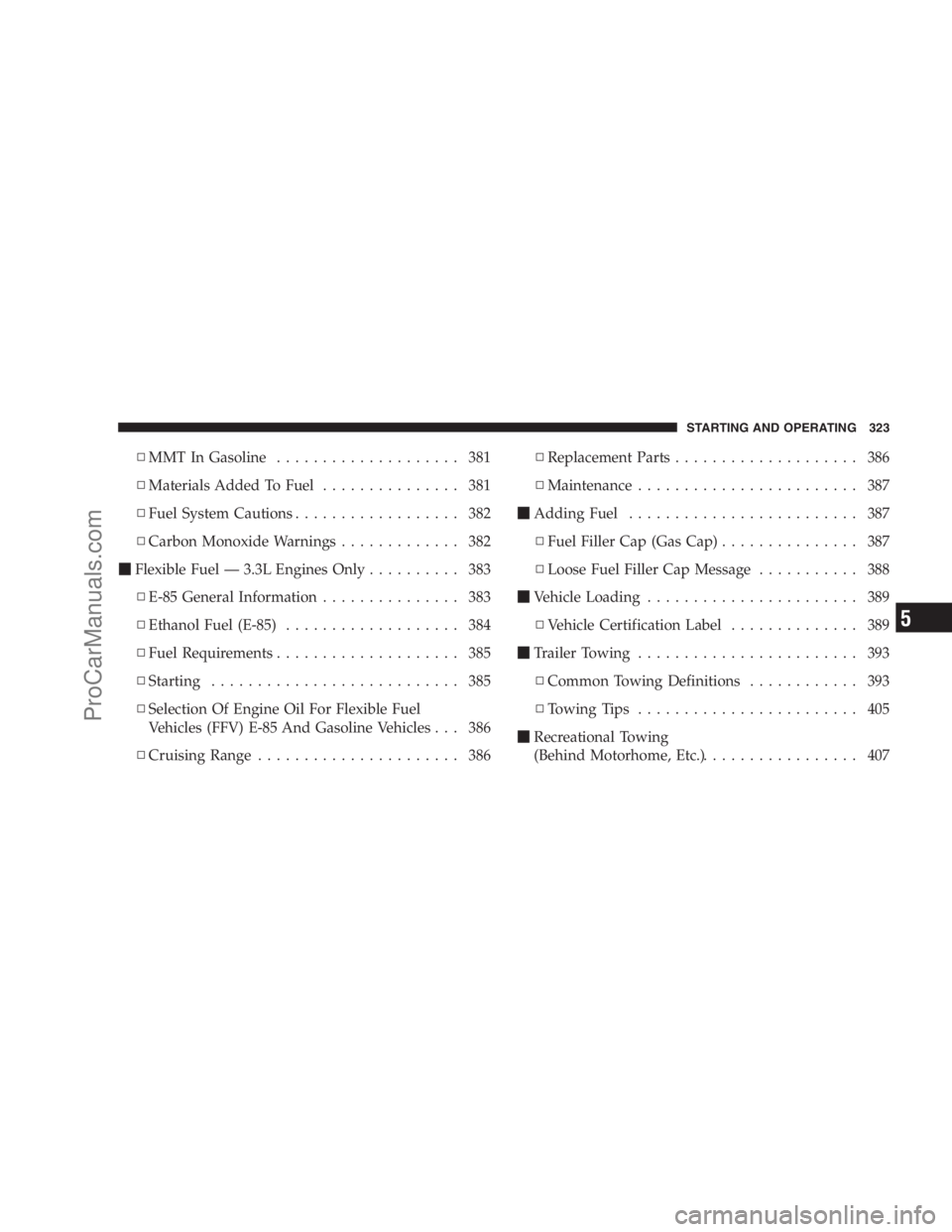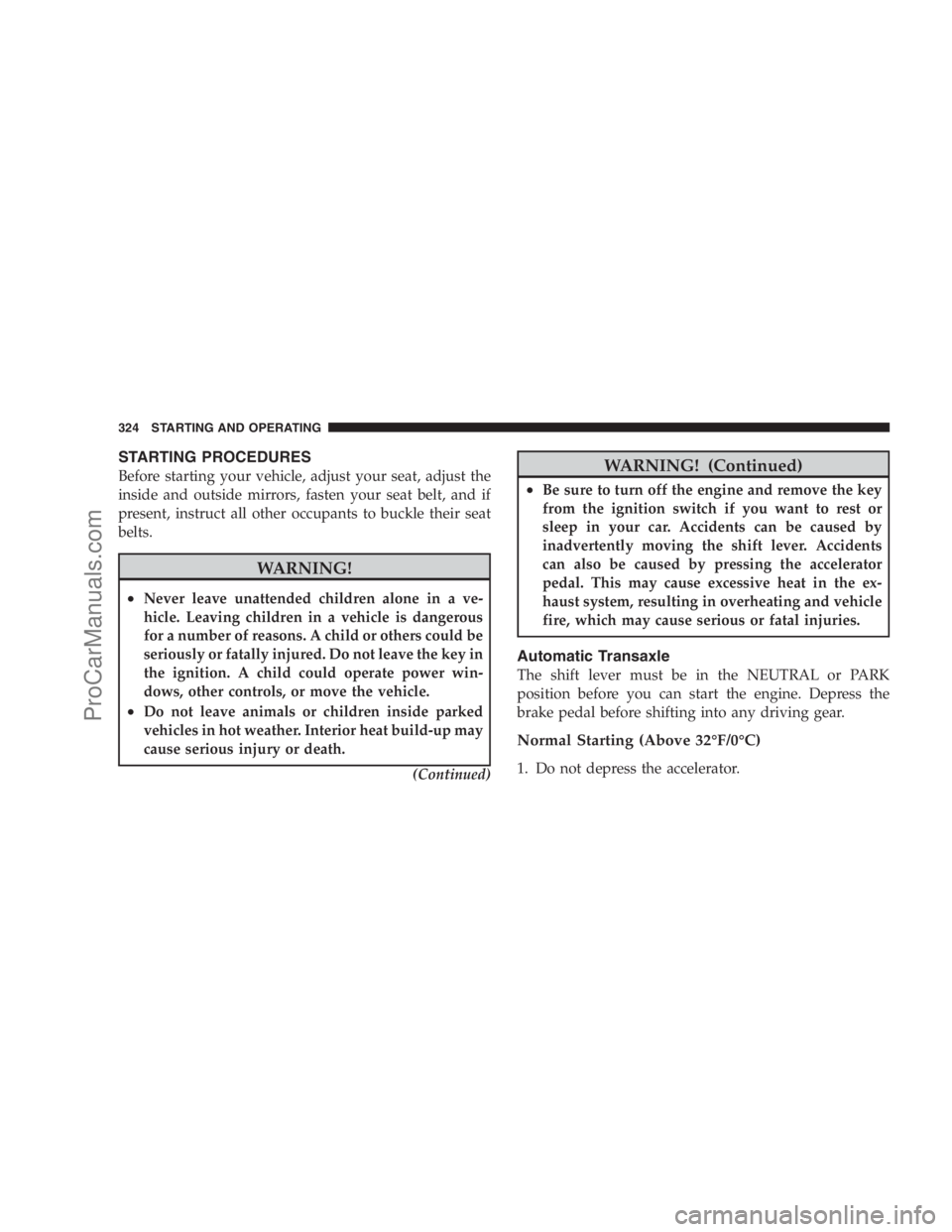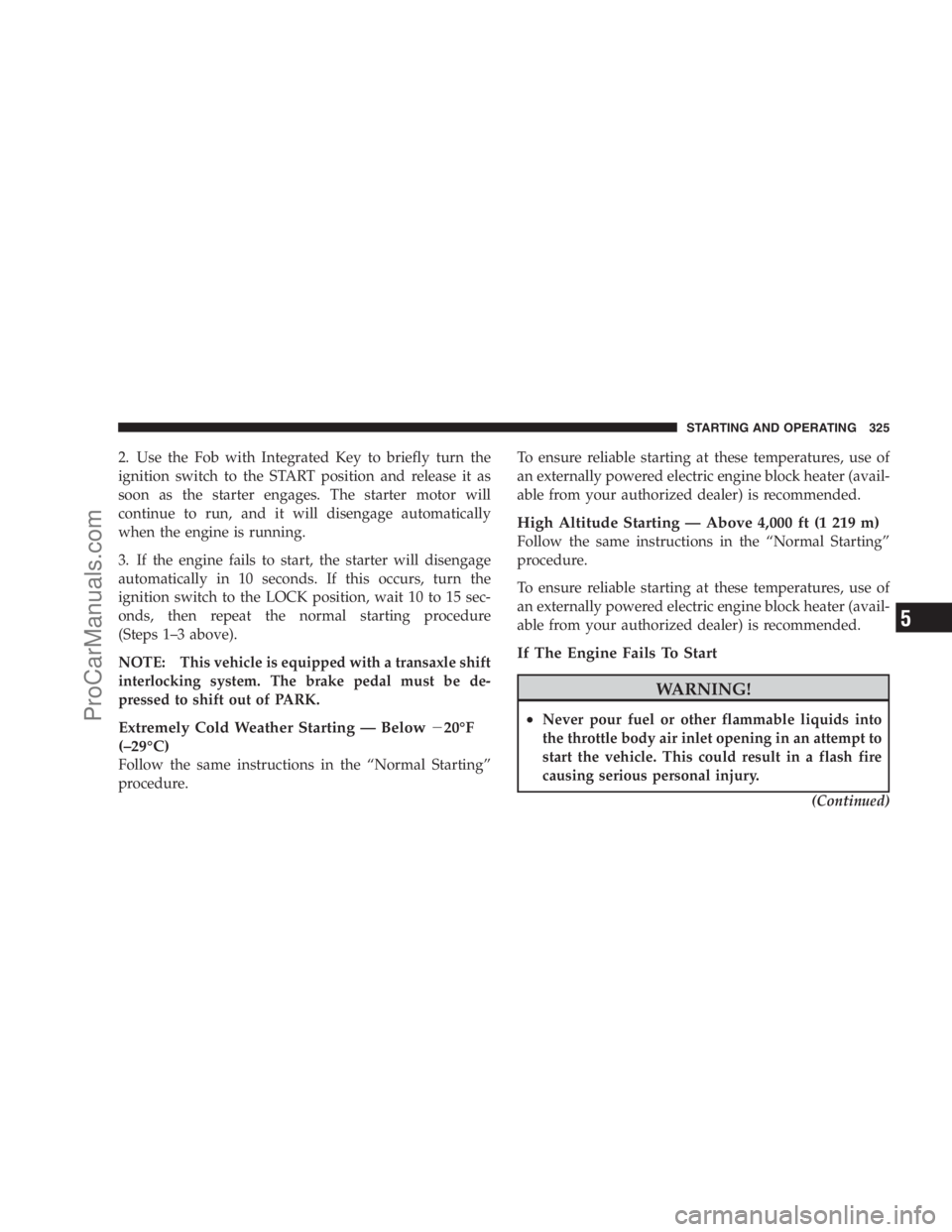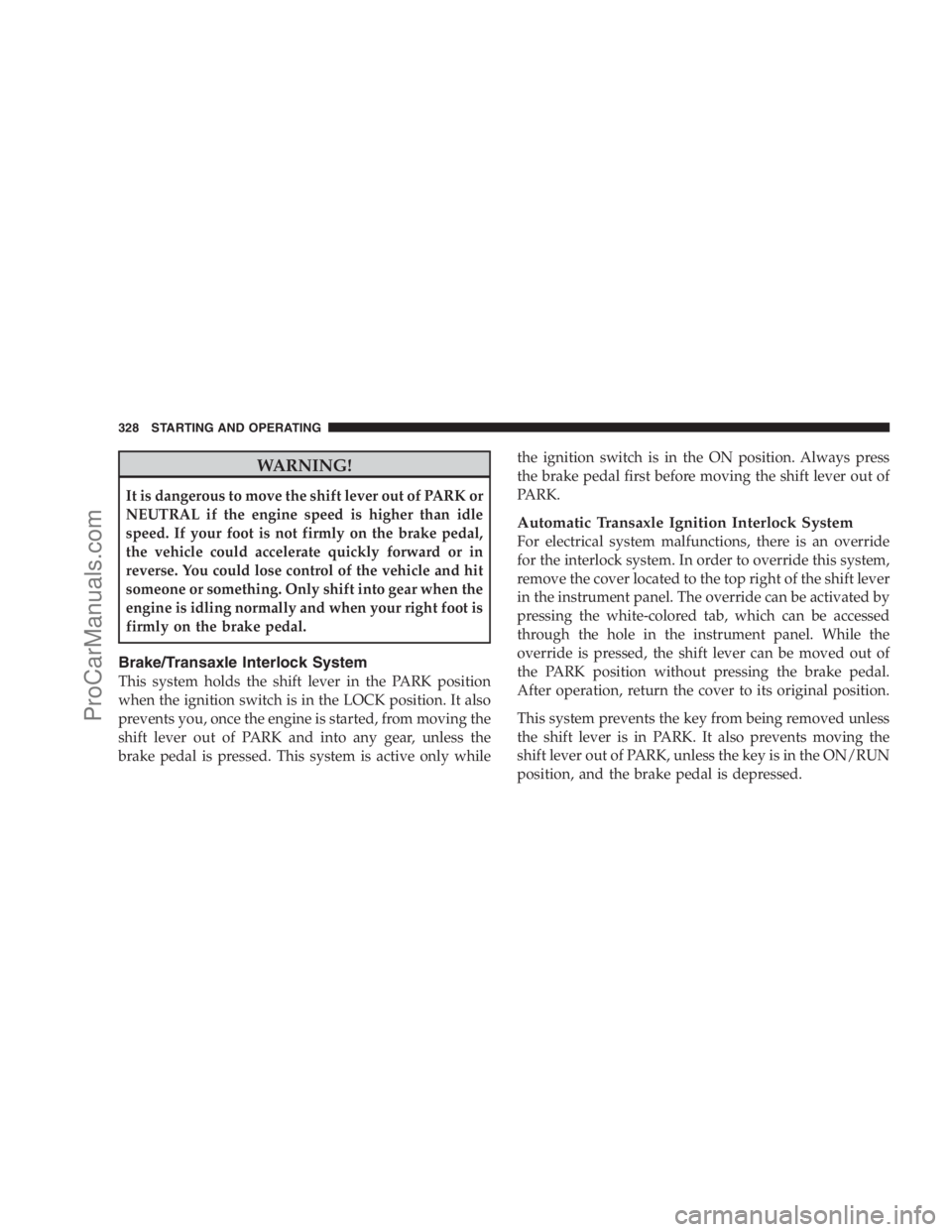Page 324 of 534

�Anti-Lock Brake System (ABS)............ 341
▫Anti-Lock Brake Light................. 343
�Brake System......................... 343
�Electronic Brake Control System........... 344
▫Traction Control System (TCS)........... 345
▫Brake Assist System (BAS).............. 346
▫Electronic Stability Program (ESP)......... 347
▫ESP/BAS Warning Light............... 348
�Tire Safety Information.................. 349
▫Tire Markings....................... 349
▫Tire Identification Number (TIN).......... 353
▫Tire Loading And Tire Pressure........... 354
�Tires — General Information.............. 358▫Tire Pressure........................ 358
�Tire Chains.......................... 367
�Snow Tires.......................... 368
�Tire Rotation......................... 369
�Tire Pressure Monitor System (TPMS)....... 370
▫Basic TPMS Without EVIC — If Equipped . . . 372
▫Premium TPMS With EVIC — If Equipped . . 374
�Fuel Requirements..................... 378
▫3.3L/3.8L Gasoline Engine.............. 378
▫4.0L Gasoline Engine.................. 379
▫Reformulated Gasoline................. 379
▫Gasoline/Oxygenate Blends............. 380
▫E-85 Usage In Non-Flex Fuel Vehicles...... 380
322 STARTING AND OPERATING
ProCarManuals.com
Page 325 of 534

▫MMT In Gasoline.................... 381
▫Materials Added To Fuel............... 381
▫Fuel System Cautions.................. 382
▫Carbon Monoxide Warnings............. 382
�Flexible Fuel — 3.3L Engines Only.......... 383
▫E-85 General Information............... 383
▫Ethanol Fuel (E-85)................... 384
▫Fuel Requirements.................... 385
▫Starting........................... 385
▫Selection Of Engine Oil For Flexible Fuel
Vehicles (FFV) E-85 And Gasoline Vehicles . . . 386
▫Cruising Range...................... 386▫Replacement Parts.................... 386
▫Maintenance........................ 387
�Adding Fuel......................... 387
▫Fuel Filler Cap (Gas Cap)............... 387
▫Loose Fuel Filler Cap Message........... 388
�Vehicle Loading....................... 389
▫Vehicle Certification Label.............. 389
�Trailer Towing........................ 393
▫Common Towing Definitions............ 393
▫Towing Tips........................ 405
�Recreational Towing
(Behind Motorhome, Etc.)................. 407
STARTING AND OPERATING 323
5
ProCarManuals.com
Page 326 of 534

STARTING PROCEDURES
Before starting your vehicle, adjust your seat, adjust the
inside and outside mirrors, fasten your seat belt, and if
present, instruct all other occupants to buckle their seat
belts.
WARNING!
•Never leave unattended children alone in a ve-
hicle. Leaving children in a vehicle is dangerous
for a number of reasons. A child or others could be
seriously or fatally injured. Do not leave the key in
the ignition. A child could operate power win-
dows, other controls, or move the vehicle.
•Do not leave animals or children inside parked
vehicles in hot weather. Interior heat build-up may
cause serious injury or death.
(Continued)
WARNING! (Continued)
•Be sure to turn off the engine and remove the key
from the ignition switch if you want to rest or
sleep in your car. Accidents can be caused by
inadvertently moving the shift lever. Accidents
can also be caused by pressing the accelerator
pedal. This may cause excessive heat in the ex-
haust system, resulting in overheating and vehicle
fire, which may cause serious or fatal injuries.
Automatic Transaxle
The shift lever must be in the NEUTRAL or PARK
position before you can start the engine. Depress the
brake pedal before shifting into any driving gear.
Normal Starting (Above 32°F/0°C)
1. Do not depress the accelerator.
324 STARTING AND OPERATING
ProCarManuals.com
Page 327 of 534

2. Use the Fob with Integrated Key to briefly turn the
ignition switch to the START position and release it as
soon as the starter engages. The starter motor will
continue to run, and it will disengage automatically
when the engine is running.
3. If the engine fails to start, the starter will disengage
automatically in 10 seconds. If this occurs, turn the
ignition switch to the LOCK position, wait 10 to 15 sec-
onds, then repeat the normal starting procedure
(Steps 1–3 above).
NOTE: This vehicle is equipped with a transaxle shift
interlocking system. The brake pedal must be de-
pressed to shift out of PARK.
Extremely Cold Weather Starting — Below�20°F
(–29°C)
Follow the same instructions in the “Normal Starting”
procedure.To ensure reliable starting at these temperatures, use of
an externally powered electric engine block heater (avail-
able from your authorized dealer) is recommended.
High Altitude Starting — Above 4,000 ft (1 219 m)
Follow the same instructions in the “Normal Starting”
procedure.
To ensure reliable starting at these temperatures, use of
an externally powered electric engine block heater (avail-
able from your authorized dealer) is recommended.
If The Engine Fails To Start
WARNING!
•Never pour fuel or other flammable liquids into
the throttle body air inlet opening in an attempt to
start the vehicle. This could result in a flash fire
causing serious personal injury.
(Continued)
STARTING AND OPERATING 325
5
ProCarManuals.com
Page 328 of 534

WARNING! (Continued)
•Do not attempt to push or tow your vehicle to get
it started. Vehicles equipped with an automatic
transaxle cannot be started this way. Unburned
fuel could enter the catalytic converter and once
the engine has started, ignite and damage the
converter and vehicle.
•If the vehicle has a discharged battery, booster
cables may be used to obtain a start from a booster
battery or the battery in another vehicle. This type
of start can be dangerous if done improperly. Refer
to “Jump Starting” in Section 6 of this manual.
If the engine fails to start after you have followed the
“Normal Starting” procedure, it may be flooded. Push
the accelerator pedal all the way to the floor and hold it
there while cranking the engine. This should clear any
excess fuel in case the engine is flooded.
CAUTION!
To prevent damage to the starter, DO NOT crank the
engine for more than 15–second intervals at one time.
Wait 10 to 15 seconds before trying again.
If the engine has been flooded, it may start to run, but not
have enough power to continue running when the key is
released. If this occurs, continue cranking with the accel-
erator pedal pushed all the way to the floor. Release the
accelerator pedal and the key once the engine is running
smoothly.
If the engine shows no sign of starting after two 15–
second intervals of cranking with the accelerator pedal
held to the floor, the “Normal Starting” procedure should
be repeated.
326 STARTING AND OPERATING
ProCarManuals.com
Page 329 of 534

After Starting
The idle speed will automatically decrease as the engine
warms up.
ENGINE BLOCK HEATER — IF EQUIPPED
The engine block heater warms engine coolant and
permits quicker starts in cold weather. Connect the
electrical cord to a standard 110-115 Volt AC electrical
outlet with a grounded, three-wire extension cord.
The engine block heater cord is routed under the hood on
the driver’s side of the vehicle. It has a removable cap
that is located on the driver side of the Integrated Power
Module.
WARNING!
Remember to disconnect the electrical cord before
driving. Damage to the 110-115 volt electrical cord
could cause electrocution.
AUTOMATIC TRANSAXLE
CAUTION!
Damage to the transaxle may occur if the following
precautions are not observed:
•Move the shift lever into PARK only after the
vehicle has come to a complete stop.
•Do not move the shift lever from REVERSE,
PARK, or NEUTRAL into any forward gear when
the engine is above idle speed.
•Before moving the shift lever into any gear, make
sure your foot is firmly on the brake pedal.
NOTE:You must press and hold the brake pedal down
while shifting out of PARK.
STARTING AND OPERATING 327
5
ProCarManuals.com
Page 330 of 534

WARNING!
It is dangerous to move the shift lever out of PARK or
NEUTRAL if the engine speed is higher than idle
speed. If your foot is not firmly on the brake pedal,
the vehicle could accelerate quickly forward or in
reverse. You could lose control of the vehicle and hit
someone or something. Only shift into gear when the
engine is idling normally and when your right foot is
firmly on the brake pedal.
Brake/Transaxle Interlock System
This system holds the shift lever in the PARK position
when the ignition switch is in the LOCK position. It also
prevents you, once the engine is started, from moving the
shift lever out of PARK and into any gear, unless the
brake pedal is pressed. This system is active only whilethe ignition switch is in the ON position. Always press
the brake pedal first before moving the shift lever out of
PARK.
Automatic Transaxle Ignition Interlock System
For electrical system malfunctions, there is an override
for the interlock system. In order to override this system,
remove the cover located to the top right of the shift lever
in the instrument panel. The override can be activated by
pressing the white-colored tab, which can be accessed
through the hole in the instrument panel. While the
override is pressed, the shift lever can be moved out of
the PARK position without pressing the brake pedal.
After operation, return the cover to its original position.
This system prevents the key from being removed unless
the shift lever is in PARK. It also prevents moving the
shift lever out of PARK, unless the key is in the ON/RUN
position, and the brake pedal is depressed.
328 STARTING AND OPERATING
ProCarManuals.com
Page 331 of 534

NOTE:If a malfunction occurs, the system will trap the
key in the ignition cylinder to warn you that this safety
feature is inoperable. The engine can be started and
stopped but the key cannot be removed until you obtain
service.
Four-Speed or Six-Speed Automatic Transaxle
NOTE:Under extreme cold temperatures (-6°F (-21°C)
and when in DRIVE, transmission operation may be
briefly limited to only 2nd gear operation. Normal op-
eration will resume once the transmission temperature
has risen to a suitable level (4–Speed Models Only).
The electronically-controlled transaxle provides a precise
shift schedule. The transaxle electronics are self-
calibrating; therefore, the first few shifts on a new vehicle
may be somewhat abrupt. This is a normal condition, and
precision shifts will develop within a few hundred miles
(kilometers).The transaxle has only PRND shift positions. Downshifts
are carried out by an Electronic Range Select (ERS) by
moving the lever—/ + while in the DRIVE position, the
instrument cluster will display transaxle gear selection as
6, 5, 4, 3, 2, 1 for six-speed, and 4, 3, 2, 1 for four-speed
transaxles.Gear Ranges
Do not race the engine when moving the shift lever from
PARK or NEUTRAL positions into another gear range.
PARK
Placing the shift lever into PARK supplements the park-
ing brake by locking the transaxle. The engine can be
started in this gear. Never attempt to use PARK while the
vehicle is in motion. Apply the parking brake when
leaving the vehicle in this gear.
STARTING AND OPERATING 329
5
ProCarManuals.com